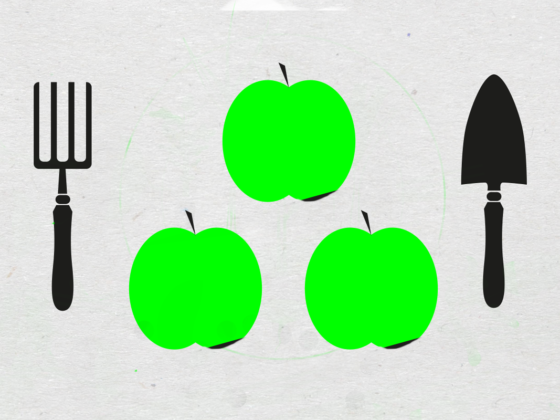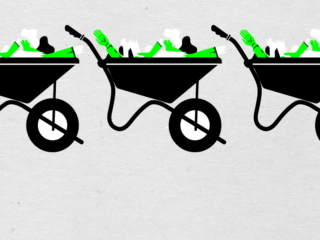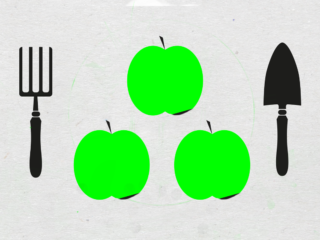IS IT EVER WORTH BUILDING RAISED BEDS FOR YOUR VEG? OR SHOULD YOU JUST FIND SOME EARTH AND START DIGGING? WE HELP YOU DECIDE

Go up? Or stay down? For those of you dreaming of starting a veg patch – and winter is the perfect time to be planning next year’s garden – this is one of those top-of-the-to-do-list questions. Do you want to grow your food directly in the ground, or would you be better building raised beds?
We’ll get into how to make that call in a moment, but first we should perhaps explain the difference. Using an open bed system simply means growing at ground level – digging over an area of soil in your garden or allotment, and then popping your veg plants in. Using raised beds, on the other hand, means growing in an area of soil that’s higher than the surrounding ground level –these days, almost inevitably held in place by some kind of boxing. Back in the early 20th century, gardeners didn’t bother with building sides for their raised beds, they mostly just mounded the earth up and got planting. But that was aeons ago, when America was still a bastion of democracy and it was naughty old Germany that was falling in love with a crypto-dictator. Which only goes to show that while gardeners progress, the rest of the world seems to be travelling in reverse.
Anyhoo. Modern-day raised beds might consist of bespoke, permanent brick structures, off-the-peg corrugated metal containers, or just a few bits of old board bolted together. In all their forms they are wildly popular – you’ll hardly see an Instagram veg patch without one – and, we would argue, not always the best choice.
That’s despite the fact we grow most of our food in them. When we first arrived at Zombie Garden HQ, we converted the rubber and sand of an old horse exercise yard into our main veg-growing area, adding chicken wire to the existing fencing to keep out the billions of rabbits that used to plague the site, and building a series of long raised beds out of semi-circular chestnut poles.
In recent years we’ve also begun to grow some food in open beds, in an area of pasture next to the sand school. We’ve found that the two methods present different challenges and, to a certain extent, suit some crops better than others.
Going Up
Whatever they’re built of, raised beds share certain advantages and disadvantages. Viz:
- They allow you to grow food in areas without any soil – like patios, driveways, balconies or roof terraces. As we explain in our book, should the zombie apocalypse start, this will be a huge plus
- On a wet, cold soil like a heavy clay, they will drain better and, in spring, warm up quicker than an open bed. This means overwintering crops will be less likely to rot, and you can start sowing earlier in the year
- Their sides make it hard for weeds that spread underground, like couch grass or nettles, to creep into the beds from path areas
- They’re higher up, so they reduce the amount of bending you have to do when you’re hand-weeding, harvesting or planting out: you can often kneel to one side instead, which is much easier on the back
- They define your growing areas. As well as looking neat and tidy, this helps you plan plantings, and also see at a glance what jobs need doing where
- As long as their sides are above xxcm high, they protect carrots from attack by their low-flying nemesis, the carrot root fly. However:
- They need building. That means using potentially expensive, carbon-heavy resources – wood, brick, metal – as well as taking up lots of your time mucking about with screws, hammers and the like
- They need filling. That may well mean buying in bags of compost or top soil. Again with the money, the carbon cost, and the time
- They dry out quicker than open beds, and so need more irrigation
- If you’re using cloche hoops to protect your plants, they have to fit inside the edges of the bed, reducing the planting area available for medium-height and tall crops
- They’re inflexible: you can’t adjust the width of the bed to accommodate extra rows for space-hungry plants such as cabbages or squash. Less plants equals less food. Annoying
- They don’t like wheelbarrows. Try to tip a barrow full of muck onto all but the lowest raised bed and its lip will catch on the side, making it really hard to get the contents out
- They don’t much like tools, either. Power tools like rotivators, long-handled tools like forks, or wheeled tools like seeders are all more difficult to use because they’re raised up and so always at slightly the wrong angle
- Their sides give lots of lovely shelter to weed seeds that blow in on the wind – as well as to our old friends, slugs and snails.
Staying low
Open beds, which you can create in a matter of hours out of an existing flower bed or an area of lawn, have less obvious advantages than raised beds – but also less problems too.
- They’re flexible: you can change their width or length from year to year, or even within a season
- They don’t require any building materials, just a spade, a fork, and your muscles
- They make using large tools easier, particularly the wheeled or engine-driven kind
- They’re wheelbarrow-friendly, which makes spreading large amounts of eg compost much simpler
- They’re fully connected with the mycorrhizal, nutrient-spreading fungal network in the surrounding soil. (This might be one reason why we seem to get better, stronger plants in our open beds)
- They make earthing up potatoes quicker, as you have access to all the soil around your bed areas to make your spud-protecting mounds
- They don’t dry out as quickly as raised beds, so need less irrigation
- They last forever and never need mending or replacing. Despite this:
- Path materials like gravel or wood chip will get kicked onto the bed across a season
- You have to bend down more to sow, plant out, harvest or hand weed
- They don’t always look as Insta-pretty as raised beds (though check out @Charles_Dowding if you want to see open beds so geometrically picture-perfect they’d make Mondrian cry)
- They’re prone to infestation by creeping weeds like thistle, buttercup or nettle
- They’re more likely to get waterlogged in wet weather
- They’ll warm up more slowly in spring.
That is, we admit, quite a lot of pros, and even more cons, to try to consider. So in the interest of making your zombie-garden planning a little simpler, here’s how we’d break it down.
Raised beds are the right choice if:
- You garden in an area with either very poor soil or no soil at all
- You want to grow lots of over-wintering crops, but your garden has heavy, waterlogged soil
- You have back or mobility problems
- You mostly want to grow low, shallow-rooted crops like salad leaves or edible flowers
- You’re growing in a relatively small space
- You’re good at DIY
- You’re not in a hurry
- You’re tidy
- You love carrots
Open beds are the right choice if…
- You garden in an area with a decent, loamy soil
- You don’t mind waiting until April to direct-sow seed (or are prepared to cover soil with black tarpaulin or weed-suppressing fabric to warm it up first)
- You don’t mind bending down all the time
- You mostly want to grow large or deep-rooted crops like runner beans, pumpkins or sprouting broccoli
- You want to use cloche tunnels and/or netting to protect your crops
- You’re growing in a relatively large space
- You loathe DIY
- You’re in a hurry
- You love potatoes
We hope this helps you make up your mind. If you’re already using one or both of these systems and can think of any pros and cons we’ve missed, do let us know, we’d love to hear from you. And here’s to some very happy bed-making!

HEAVY CLAY This is either a) a wet and rather cold soil made up of very small mineral particles; b) a depressing and rather worrying soil that brings down everyone’s mood; or c) both.










